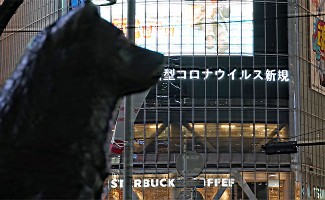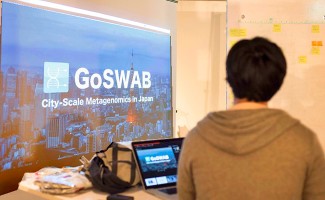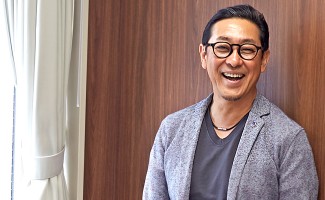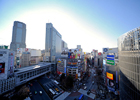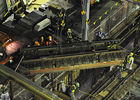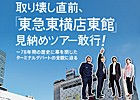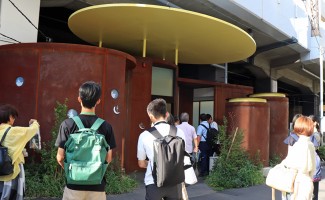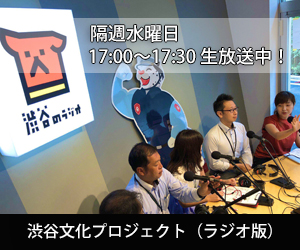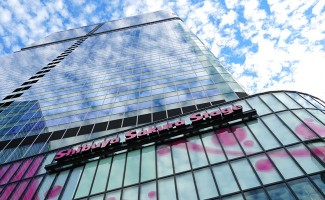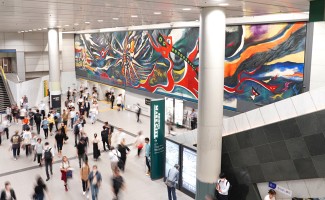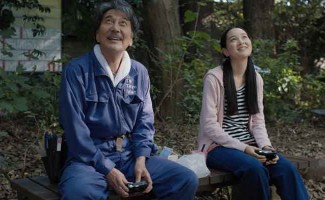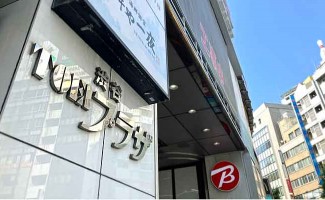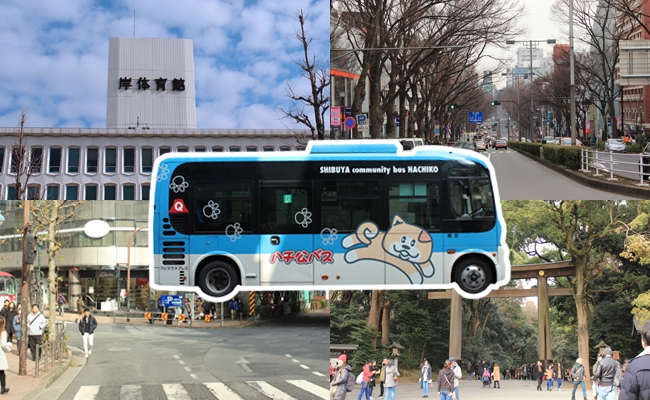
Learn the "Shibuya" from zero - Hachiko view from the bus landscape of "Shibuya" Part 2
My Shibuya amateur, the second round of began to know the "Shibuya", "Hachiko bus journey". Root of community bus "Hachiko bus" Shibuya-ku, is operated, "route over the hill (Uehara, Tomigaya direction)," "Mori root of the Shrine (Jingumae-Sendagaya direction)" "Spring of Ogawa root (Hon-Sasazuka direction) 4 lines of, "" Yuyakekoyake root (Ebisu Daikanyama district). " The last time, "route over the hill (Uehara, Tomigaya direction)" which was introduced in the first round is the name Street, Shibuya terrain and that the unevenness of, can experience a variety rich streets "Shibuya of depth keenly Course" It was was (see the previous article for more information).
>First round: route over the hill ~ Uehara, Tomigaya direction (2015.12.24)
Well, ... and I might try a second time on any route, try to look at each of the routes in the HP of "Hachiko bus". The remaining three routes, as compared to the "over the hill route", which also seems of little longer route, this time to select the "Du root of the Shrine."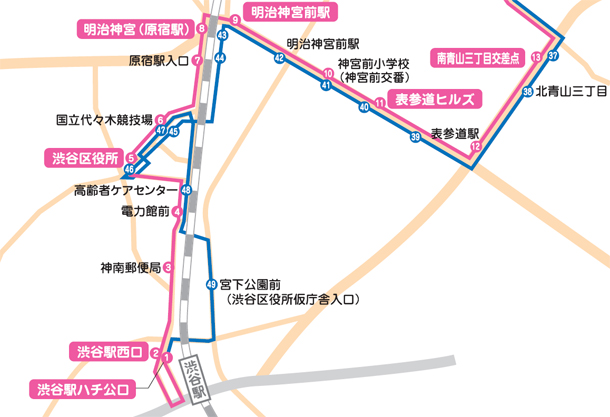 reference:Shibuya-ku Community Bus Hachiko bus "Shrine of Mori (Mori) route"
reference:Shibuya-ku Community Bus Hachiko bus "Shrine of Mori (Mori) route"
This route Yoyogi National Stadium, Meiji Shrine, Omotesando, Aoyama Street, seems to have around the Tokyo Metropolitan Gymnasium and Tokyo attractions. Even much Shibuya amateur me, this area is not visited many times, familiar only place. Even a little longer route, as long as a place where know was, is also supposed to be reduced much of! Is that the reason why you chose the second times. Rather, too familiar place, or not than not so much that it is possible to newly discovered, and had been worried .... Has become a fact now finishing the interview about regret, "This was to be the root of the bird!", It was a magnificent Shibuya route past and present story has been inclusion of.
In, trying to introduce the "Du root of the Shrine."
Hachiko view from the bus landscape of "Shibuya"
Second: Du root of Jingu - Jingumae-Sendagaya direction - (prequel)
Start the "1. Shibuya Station". There is a side to the stop of the smoking area in the Hachiko wicket. The body of the bus to go to "Du root of the Shrine" is blue, "Q" and drawn Fujikyu Highland logo (currently at the center of the mark in the shape of Mount Fuji in the rear is used as the logo of Fujikyu group ) it has been written.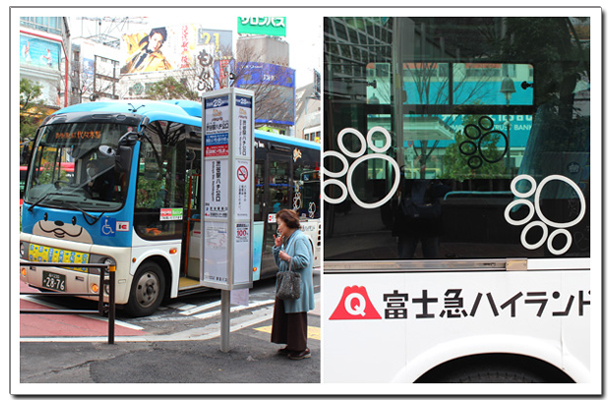 "Du root of the Shrine" is a bus that is operated commissioned Shibuya Ward to Fuji Express. Fujikyu of that amusement park, know for the first time that you are also operated bus.
"Du root of the Shrine" is a bus that is operated commissioned Shibuya Ward to Fuji Express. Fujikyu of that amusement park, know for the first time that you are also operated bus.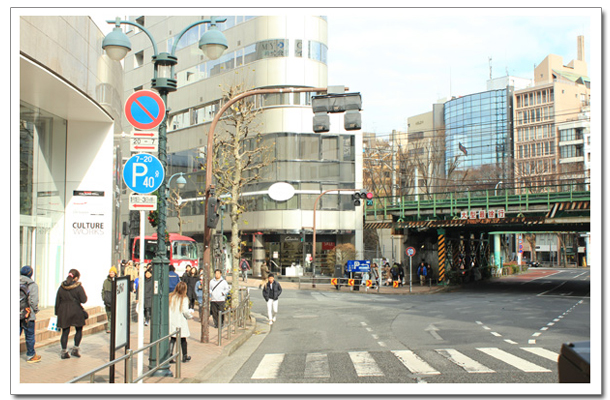 Bus is starting from here, take a course in the opposite direction around all round the Shibuya Station West of bus rotary, through between the 109 Men's Building and TSUTAYA, go straight north. Familiar scenery of Shibuya is spread on both sides. Bus stop in "4. Electric Power Pavilion before" next to TEPCO. Electric Power Pavilion that is to stop name, but was reopened scheduled for March 20, 2011, postponed due to the influence of what happened was the Great East Japan Earthquake in March of the same year 11 days, and as it is a closing. Currently, borrows is SHiDAX with headquarters next to, but so culture school and sports club called "Culture Works" has become a fusion facility.
Bus is starting from here, take a course in the opposite direction around all round the Shibuya Station West of bus rotary, through between the 109 Men's Building and TSUTAYA, go straight north. Familiar scenery of Shibuya is spread on both sides. Bus stop in "4. Electric Power Pavilion before" next to TEPCO. Electric Power Pavilion that is to stop name, but was reopened scheduled for March 20, 2011, postponed due to the influence of what happened was the Great East Japan Earthquake in March of the same year 11 days, and as it is a closing. Currently, borrows is SHiDAX with headquarters next to, but so culture school and sports club called "Culture Works" has become a fusion facility.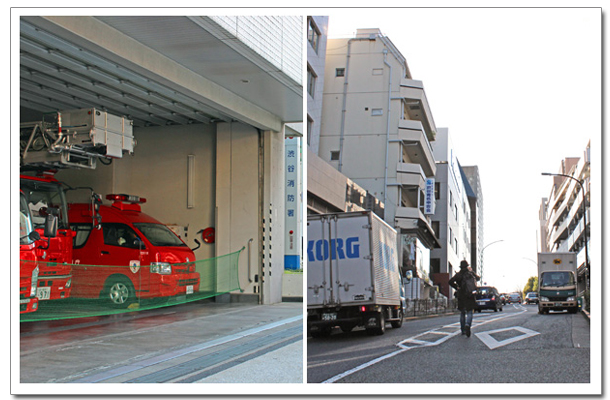 The bus, as it is north, turn left at the Shibuya fire department, come see the building that contains the Hello Work Shibuya and Rokisho in the right hand.
The bus, as it is north, turn left at the Shibuya fire department, come see the building that contains the Hello Work Shibuya and Rokisho in the right hand.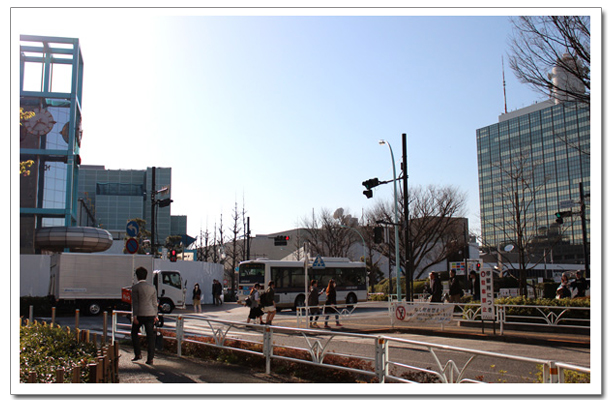 When you turn off to climb the hill, spread views that were familiar to previous eyes. Shibuya on the left ward office, Gate of the NHK west entrance before, in the right hand 2.5-dimensional musical dedicated theater "AiiA 2.5 Theater Tokyo (AIA 2.5 Theater Tokyo)," said Shibuya landmark we are built. While it may be many people unfamiliar with "2.5-dimensional", the world of manga and anime, games, those stage works of such musical. Anime fan, of course, recently, that has also gained popularity as a tourist spot of foreign travelers.
When you turn off to climb the hill, spread views that were familiar to previous eyes. Shibuya on the left ward office, Gate of the NHK west entrance before, in the right hand 2.5-dimensional musical dedicated theater "AiiA 2.5 Theater Tokyo (AIA 2.5 Theater Tokyo)," said Shibuya landmark we are built. While it may be many people unfamiliar with "2.5-dimensional", the world of manga and anime, games, those stage works of such musical. Anime fan, of course, recently, that has also gained popularity as a tourist spot of foreign travelers.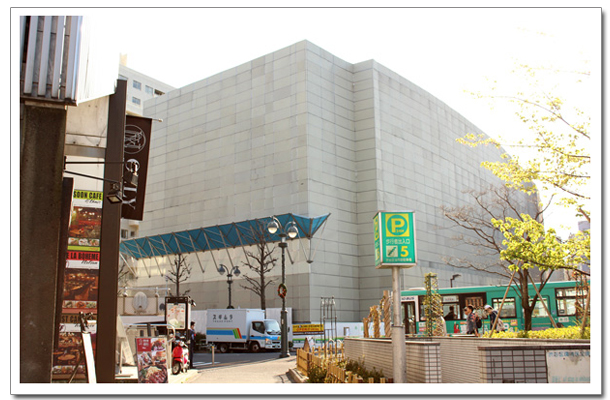 Well, there is a public toilet just around the Shibuya ward office before the intersection in front to the right, arrive at the stop "5. Shibuya Ward Office" next to it. Ward and Shibuya Public Hall in the back is in the rebuilding work, are covered in a white sheet. Ward office, from where there is a TEPCO and the old power museum that has passed through earlier, moved to this area in 1965. Currently, from October 2015 due to the aging, it has been transferred to the provisional government buildings near Miyashita park. New building is scheduled for completion in 2018. High-rise apartment also seems located in the back of the ward office and auditorium. This familiar landscape also it means that in two years has changed dramatically.
Well, there is a public toilet just around the Shibuya ward office before the intersection in front to the right, arrive at the stop "5. Shibuya Ward Office" next to it. Ward and Shibuya Public Hall in the back is in the rebuilding work, are covered in a white sheet. Ward office, from where there is a TEPCO and the old power museum that has passed through earlier, moved to this area in 1965. Currently, from October 2015 due to the aging, it has been transferred to the provisional government buildings near Miyashita park. New building is scheduled for completion in 2018. High-rise apartment also seems located in the back of the ward office and auditorium. This familiar landscape also it means that in two years has changed dramatically.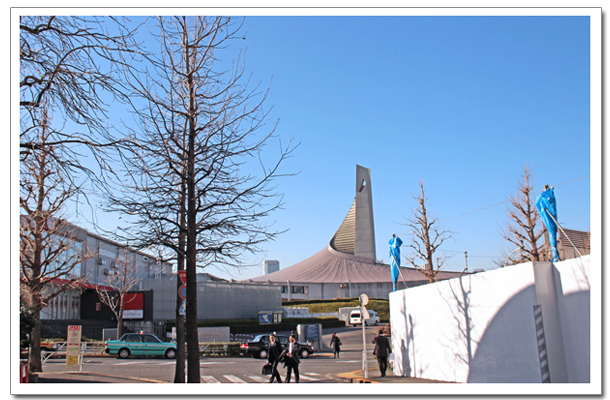 And turn left out of the this stop, field of view, which has been blocked by the public toilet is open Innovation loaders, verge Yoyogi National Stadium appears to be. ...... No, spread on top of the Yoyogi National Stadium "Shibuya of the sky" has appeared. In the land of Tokyo, it is a long time to see the sky spread To spacious not so blocked anything. Get off at "6. Yoyogi National Stadium", I decided to try to close to this building.
And turn left out of the this stop, field of view, which has been blocked by the public toilet is open Innovation loaders, verge Yoyogi National Stadium appears to be. ...... No, spread on top of the Yoyogi National Stadium "Shibuya of the sky" has appeared. In the land of Tokyo, it is a long time to see the sky spread To spacious not so blocked anything. Get off at "6. Yoyogi National Stadium", I decided to try to close to this building.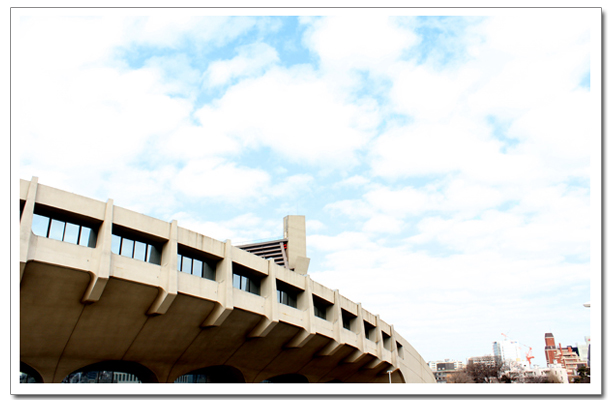 Enter from the parking lot on the stop side, and climb the stairs, Yoyogi National Stadium First Gymnasium stood solemnly. Oh, the weather would be nice Nante today. Around the gymnasium, seems to have become a bit of a walk course, people are spending a leisurely. Suggests also how the foreign tourists who have the camera toward the first gymnasium. This building is, I have the course here, but is a masterpiece of architect Kenzo Tange. Although distant be viewed as a landmark from the location there, it is the first time I've seen from so nearby. There is also a fact that stands on a little hill, and no one is in the way of the sky and the gymnasium around. I know the look at the Yoyogi first gymnasium, it seems to have very much looking at the "empty". Shibuya of the middle, become .... well very elegant feeling there is a place to feel so empty. I think I want to come back to the time of calm.
Enter from the parking lot on the stop side, and climb the stairs, Yoyogi National Stadium First Gymnasium stood solemnly. Oh, the weather would be nice Nante today. Around the gymnasium, seems to have become a bit of a walk course, people are spending a leisurely. Suggests also how the foreign tourists who have the camera toward the first gymnasium. This building is, I have the course here, but is a masterpiece of architect Kenzo Tange. Although distant be viewed as a landmark from the location there, it is the first time I've seen from so nearby. There is also a fact that stands on a little hill, and no one is in the way of the sky and the gymnasium around. I know the look at the Yoyogi first gymnasium, it seems to have very much looking at the "empty". Shibuya of the middle, become .... well very elegant feeling there is a place to feel so empty. I think I want to come back to the time of calm.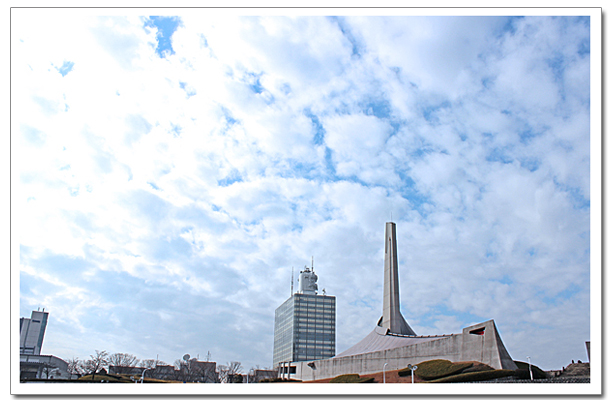 When directed to the left and a second gymnasium, in the back see the NHK Broadcasting Center. But where you want to more laid-back, but in the order of the route this stop is still a "6", the beginning also a beginning. Hurry ahead.
When directed to the left and a second gymnasium, in the back see the NHK Broadcasting Center. But where you want to more laid-back, but in the order of the route this stop is still a "6", the beginning also a beginning. Hurry ahead.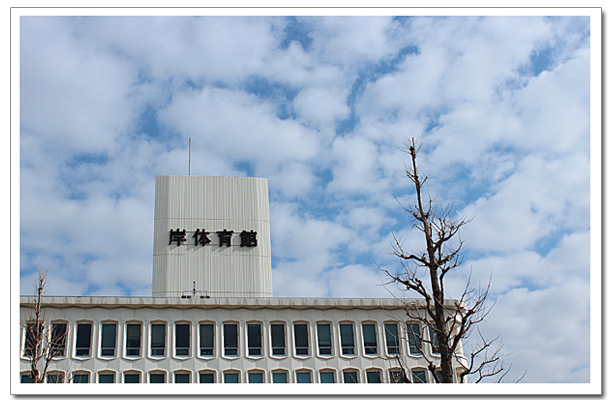 Down the stairs, waiting for the bus to return to the stop. Is built is "Kishi Memorial Gymnasium" is the opposite of the stadium. Kishi Memorial Gymnasium is the Japanese Olympic Committee and the Japan Sports Association, entered the headquarters of many other domestic sports associations building. Kishi Memorial Gymnasium was built in the Kanda in 1941, is that of the Tokyo Olympic Games just before the 1964's have been moved to this land. This year, due to the aging, rebuilding has been decided to Jingu Outer Gardens district. Towards the Tokyo Olympics in 2020, it means that the new National Stadium is move to the district to be built. This is on the first floor basement of the building there is a reference room that Japan Amateur Sports Association to manage, it is also the general public of the viewable. "Oh, either. Looking a little closer," came the bus I thought. Yes, it was rush ahead.
Down the stairs, waiting for the bus to return to the stop. Is built is "Kishi Memorial Gymnasium" is the opposite of the stadium. Kishi Memorial Gymnasium is the Japanese Olympic Committee and the Japan Sports Association, entered the headquarters of many other domestic sports associations building. Kishi Memorial Gymnasium was built in the Kanda in 1941, is that of the Tokyo Olympic Games just before the 1964's have been moved to this land. This year, due to the aging, rebuilding has been decided to Jingu Outer Gardens district. Towards the Tokyo Olympics in 2020, it means that the new National Stadium is move to the district to be built. This is on the first floor basement of the building there is a reference room that Japan Amateur Sports Association to manage, it is also the general public of the viewable. "Oh, either. Looking a little closer," came the bus I thought. Yes, it was rush ahead.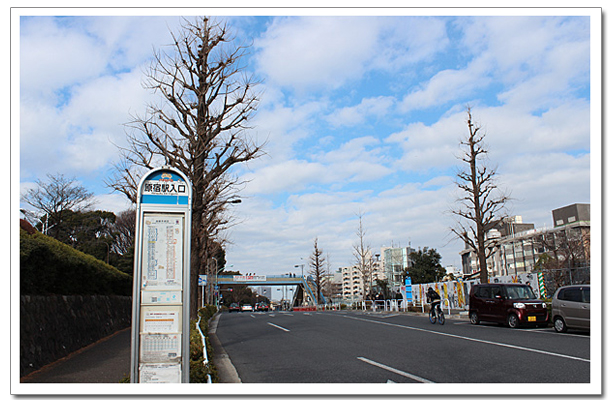 Bus, turn left at the shore Memorial Taiikukanmae intersection, proceed with the aim along the line Harajuku Station. In the line side of the sidewalk or would be taken of the magazine, female models have devoted a reflector. Looking at the before, the land bridge that says "Shibuya-ku Kamizono town" has been looked blue. Finally going into the main theme of "Mori root of the Shrine." Bus is finely stop the "7 Harajuku Station entrance" "8 Meiji Shrine." Of course I was getting off the bus.
Bus, turn left at the shore Memorial Taiikukanmae intersection, proceed with the aim along the line Harajuku Station. In the line side of the sidewalk or would be taken of the magazine, female models have devoted a reflector. Looking at the before, the land bridge that says "Shibuya-ku Kamizono town" has been looked blue. Finally going into the main theme of "Mori root of the Shrine." Bus is finely stop the "7 Harajuku Station entrance" "8 Meiji Shrine." Of course I was getting off the bus.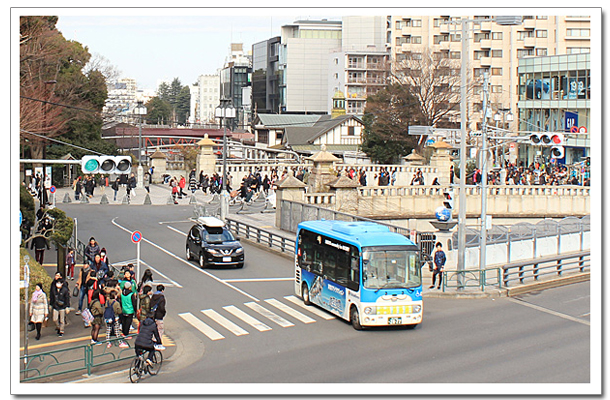 To say that it is a weekday, with tourists and students and parents and children with a camera, everywhere was full. The point is, Yoyogi Park, Meiji Jingu Shrine, downtown of Harajuku, a junction of the three places of, is the entry. 'm Again I wonder Adjacent space of completely different layers. Take the flow of tourists, try approaching the forest of Meiji Shrine.
To say that it is a weekday, with tourists and students and parents and children with a camera, everywhere was full. The point is, Yoyogi Park, Meiji Jingu Shrine, downtown of Harajuku, a junction of the three places of, is the entry. 'm Again I wonder Adjacent space of completely different layers. Take the flow of tourists, try approaching the forest of Meiji Shrine.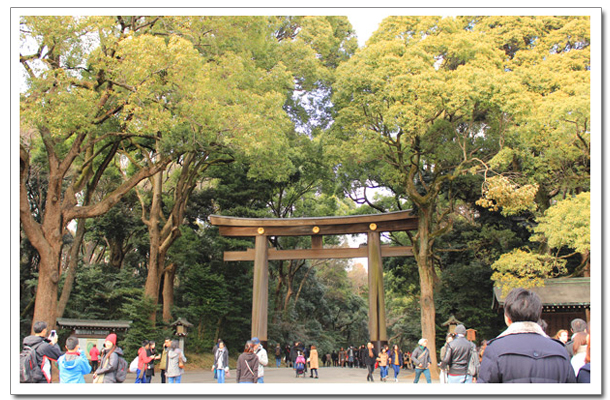 Stand in front of the torii of Meiji Shrine. As wood is a huge torii that it is up to Japan. Which has been created using the cypress-old 1500 years, height 12m, width 17m, the thickness of the pillar is also 1.2m. In front of the torii, and I wonder if this tip is going on, try to expand the map of Shibuya-ku, mixed with tourists. Looking at the map, the Meiji Shrine, notice that you are located in the heart of Shibuya. At the same time, it surprised very that accounts for more than expected in the occupied area. Meiji Shrine is a total area of about 700,000 square meters, but there's also 15 Tokyo Domes. Looking at the map, the center of Shibuya-ku, is filled with green. Alone I am in this position can not notice the size. No way in the back, I'm surprised is that the spread is such a huge forest. This breadth will be renewed sense at the root of the post.
Stand in front of the torii of Meiji Shrine. As wood is a huge torii that it is up to Japan. Which has been created using the cypress-old 1500 years, height 12m, width 17m, the thickness of the pillar is also 1.2m. In front of the torii, and I wonder if this tip is going on, try to expand the map of Shibuya-ku, mixed with tourists. Looking at the map, the Meiji Shrine, notice that you are located in the heart of Shibuya. At the same time, it surprised very that accounts for more than expected in the occupied area. Meiji Shrine is a total area of about 700,000 square meters, but there's also 15 Tokyo Domes. Looking at the map, the center of Shibuya-ku, is filled with green. Alone I am in this position can not notice the size. No way in the back, I'm surprised is that the spread is such a huge forest. This breadth will be renewed sense at the root of the post.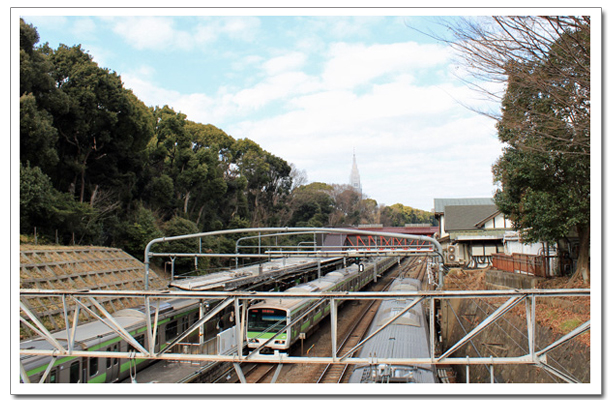 Walk to Omotesando along the side of the forest that spreads along the YAMANOTE LINE . "9. Meiji-Jingumae Station" is also passed and I decided to walk on this street.
Walk to Omotesando along the side of the forest that spreads along the YAMANOTE LINE . "9. Meiji-Jingumae Station" is also passed and I decided to walk on this street.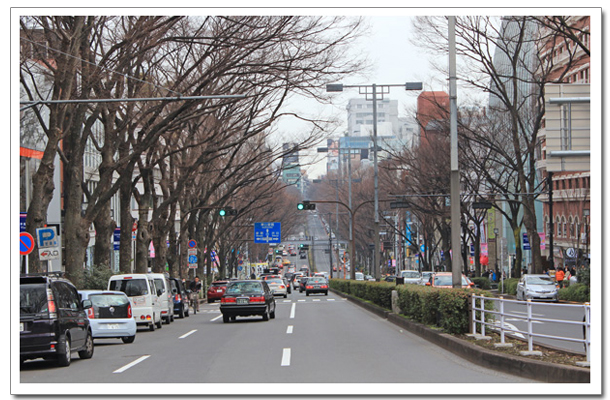 Omotesando is to the east, and extends to nothing but straight. Comfortably to this straight line, it has been increased above by Zelkova (Zelkova) Namiki planted aside. This road 1920 is the approach to the Meiji Shrine, was born in accordance with the founding of the Meiji Shrine, also zelkova tree-lined in the following year afforestation. But, the main hall in the air raid on Tokyo in April 1945 burned down, lost even the majority of the zelkova tree-lined in the same year in May. Shrine of the main hall was rebuilt in 1958, by this zelkova tree-lined of people who were involved at the time of the foundation Jingu privately financed, are those that were replanted in 1950.
Omotesando is to the east, and extends to nothing but straight. Comfortably to this straight line, it has been increased above by Zelkova (Zelkova) Namiki planted aside. This road 1920 is the approach to the Meiji Shrine, was born in accordance with the founding of the Meiji Shrine, also zelkova tree-lined in the following year afforestation. But, the main hall in the air raid on Tokyo in April 1945 burned down, lost even the majority of the zelkova tree-lined in the same year in May. Shrine of the main hall was rebuilt in 1958, by this zelkova tree-lined of people who were involved at the time of the foundation Jingu privately financed, are those that were replanted in 1950.
"I think I see ..." come up here. I "Shibuya" of the route has been followed now, the lost war and the subsequent Tokyo Olympic Games is the location of the that can not be said.
Meiji Shrine is one that was built as your deity of the Emperor Meiji and the Akinori Empress Dowager in 1920. The role that this was created in the Taisho "forest of the village shrine" is played on until the end of the war will not be considered separately from the history of the Meiji state. Guardian angel Meiji Shrine which has been functioning as the empire is taking a barrage of B29, that although many of the buildings, including the main hall were affected, was at most of the refuge of people at the same time. This forest made of evergreen broad-leaved tree is strong in fire, forest kept the people. Mori is the remaining fled the war.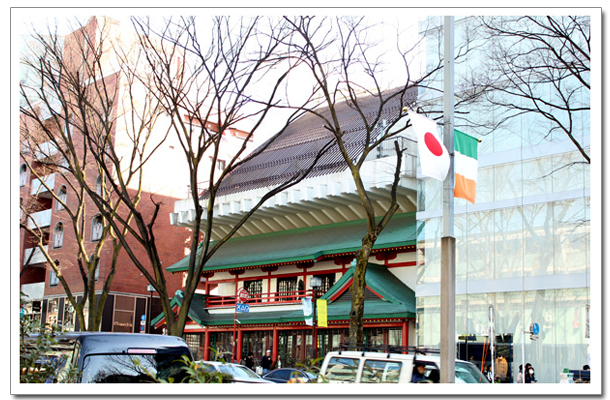 Per Yoyogi Park is, where there was a parade ground of the Japanese Army until the end of the war. After the end of the war, it becomes a Washington Heights the US military and their families et al live, but so wealthy officer class lived. Officer who passes through the Omotesando, which is beautifully appointed, was commuting to GHQ headquarters. In their impact Harajuku is going to change to international city. In the Omotesando "Kiddy Land" and "Oriental Bazaar", it began operating as a store for the residents of Washington Heights is a famous story.
Per Yoyogi Park is, where there was a parade ground of the Japanese Army until the end of the war. After the end of the war, it becomes a Washington Heights the US military and their families et al live, but so wealthy officer class lived. Officer who passes through the Omotesando, which is beautifully appointed, was commuting to GHQ headquarters. In their impact Harajuku is going to change to international city. In the Omotesando "Kiddy Land" and "Oriental Bazaar", it began operating as a store for the residents of Washington Heights is a famous story.
In the previous year Tokyo Olympic Games in 1963, Washington Heights are returned to Japan, the Olympic Athletes' Village, Yoyogi National Stadium, the International Broadcast Center, become Shibuya Public Hall. NHK is transferred to the International Broadcast Centre in 1965 after the Olympic Games, Shibuya ward office also moved to now of the land in the same year. Athletes village is in place, the current Yoyogi Park is born. Shibuya is in the wake of the Tokyo Olympics, it goes through a sea change that could not have the imagination before the war.
Walk straight Omotesando. Even walking the streets, the smell of war and occupation is not felt at all. Most of the young people who go city is, would not know that there is such a history in this town. Harajuku think as wash away the memory of such a history. Harajuku is also yet downtown, is known as the first time the designated city in educational district of Tokyo in 1957. This is heard that thing of there is also the efforts of people of the town council. It prospered as a temple town of the Holy Land of the Meiji Jingu, become the burnt ruins by the war, was occupied by the US forces, and became the exotic city. And at the same time dramatically in the Tokyo Olympic Games, it has been changed to the town creators who were attracted to this cityscape gather. This town, which has changed the variety and appearance along with the flow of the so history is, that is the city that has been crafted by more live people of hand from time to time. Harajuku is, while there is between Shinjuku and Shibuya, this is given to two of the city continued to also exists as a heterogeneous space, nothing other than the presence of the residents was the Meiji Jingu trying to protect this area. And the forest of Meiji Shrine, downtown called Harajuku, but is hard to understand at first glance to exist side-by-side is this foreign place, it probably was inevitable. It, to check into the history of this town.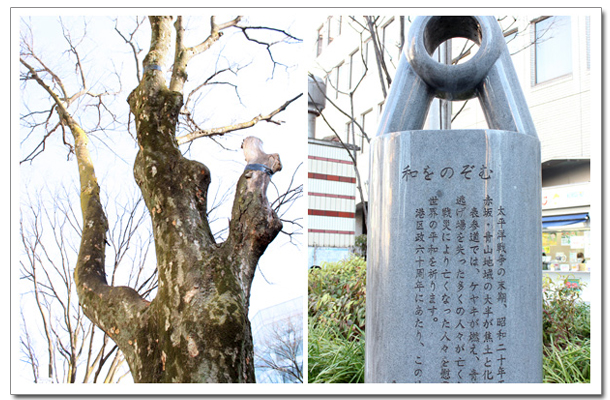 As I wrote before and not felt the memories of the war, here is left even those that feel it now. One of Zelkova in front Omotesando Hills, it is a tree that escaped the war. It becomes 90 years old. Also located in the Omotesando intersection, memorial is built to the Mizuho Bank aside. Although people who fled to the Meiji Shrine by the air raid had survived, people who fled to the Aoyama district can not escape from the war, but so many people died.
As I wrote before and not felt the memories of the war, here is left even those that feel it now. One of Zelkova in front Omotesando Hills, it is a tree that escaped the war. It becomes 90 years old. Also located in the Omotesando intersection, memorial is built to the Mizuho Bank aside. Although people who fled to the Meiji Shrine by the air raid had survived, people who fled to the Aoyama district can not escape from the war, but so many people died.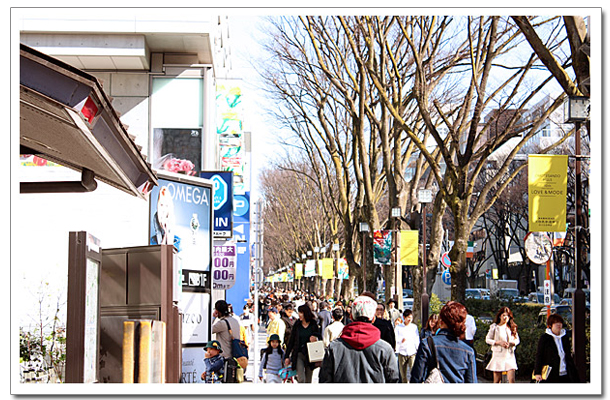 Try again looking at the beautiful zelkova tree-lined. This town is the history was over and over again a city that Deki to overlap over and over again. While feeling such a huge story, ride along with the guests of shopping the way home in the "11. Omotesando Hills" to the bus. Bus will turn left at the Omotesando intersection, run the Aoyama Street.
Try again looking at the beautiful zelkova tree-lined. This town is the history was over and over again a city that Deki to overlap over and over again. While feeling such a huge story, ride along with the guests of shopping the way home in the "11. Omotesando Hills" to the bus. Bus will turn left at the Omotesando intersection, run the Aoyama Street.
(To be continued to the next issue Part II)

Akiko Obara
Born in 1981. I like Tokyo. Tokyo to becomes in about 15 years, from the time that landed for the first time in Tokyo, continue to be fascinated by all the way up to now. In, Shibuya? "The thing of Shibuya senior, I am the presumptuous Nante to determine whether love or hate ..." and would with heard the mood. And I are always tried in the city of Shibuya. Unforgivable care. Such I feel that. Although it was the image of poor seniors, I think this time, and let's jump into the bosom of ventured senior. A result, what is flung by shouldering one, what is hug, or Hata also unexpected things will happen. Shibuya freshman challenge.
